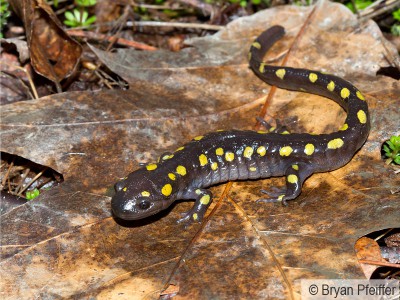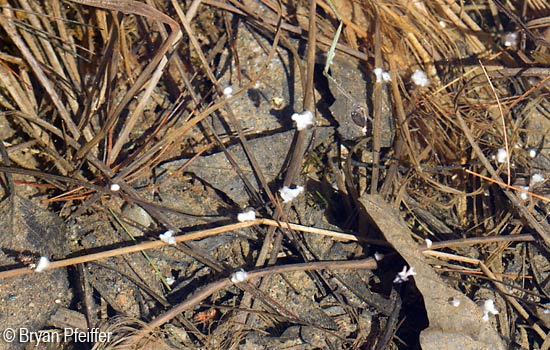What’s This? No. 1
Here’s the debut image in my “What’s This?” challenge. The normal location for this twig is under water. I pulled it up for a photo on April 17, 2013. What are the little white lumps? The first to name them gets fame on bryanpfeiffer.com and $5 off any of Bryan’s outings or workshops. Read on for the R-rated answer.
Added April 25: We have a winner: David Alexander, who blogs at Nature Into Action. David identified these white blobs as – yeah, you guessed it – Spotted Salamander sperm. (Other folks, listed below in comments, got this right as well, but David was first. An honorable mention goes to Andrea, who invoked maple creamees.)
We call these mounds “spermatophores.” It turns out that salamanders don’t breed like, well, like the rest of us. Sure, they prefer it wet and wild. But they only get to do it once a year. But they do it many times. Well, sort of. Okay, it’s complicated.
 Most of the year, Spotted Salamanders (Ambystoma maculatum) are content in the forest underground, feeding on worms, slugs, insects and other yummy arthropods that wander by. But April is their kindest month. They emerge for a once-a-year orgy.
Most of the year, Spotted Salamanders (Ambystoma maculatum) are content in the forest underground, feeding on worms, slugs, insects and other yummy arthropods that wander by. But April is their kindest month. They emerge for a once-a-year orgy.
The party happens when vernal rains dampen the woods. On those wet nights, Spotted Salamanders and other amphibians emerge and make their way to a wet, wild, woodland singles bar – the vernal pool. Fed only by snowmelt and rainwater, vernal pools are precious wetlands worthy of protection in their own right. They dry up in late summer, which means no fish to bother (eat) our amphibians, particularly during sex. And for salamanders, sex is mostly group foreplay – nudging and rubbing in a wriggling mass.
From this debauchery, males wander away to deposit their sperm – the spermatophores – on twigs and leaves for all the world to see. (I’ve included another photo below.) Females come by later, straddle the pile, and gather spermatophores into their cloacas. Eureka! Fertilization. Salamander satisfaction.
 In this mating system, a particular male may fertilize more than one female, and each female may collect sperm from several males. It’s promiscuity squared – free love but without all the fun.
In this mating system, a particular male may fertilize more than one female, and each female may collect sperm from several males. It’s promiscuity squared – free love but without all the fun.
From there, the female will lay her eggs in a gelatinous mass circled around an underwater twig. They’ll hatch into tiny salamander larvae and mature through the summer with a life goal of emerging from the pool before it dries up, onward back to the earth, back underground — at least until the warming rains of next April.


An honorable mention for creativity. Thanks, Andi! See you at the checkout!
This is easily the most vivid of answers. Thanks, Sara!
You got it, Joan. A few were quicker at the clicking. But thanks!
Yep! Thanks, Jennifer. David beat you to the post!
Oh, you hit the “buzzer” just after David. But that’s the right answer. Thanks, Sue!
We have a winner!
You and Judy think alike, Laurie. So close! Thanks!
A great answer, Judy. In the ballpark, er, I mean pond. Thanks!
Drips off the first creamies of spring. Probably maple flavored.
I say it’s a soggy pussy willow with frozen buds. (If I’m right, do I win it?)
Salamander spermatophores?
Yellow spotted salamander spermatophore
i’m going to say a spermatophore of a spotted salamander?
Spotted? Salamander Spermatophors
Are these Spring Peeper eggs?
I think these might be spring peeper eggs.